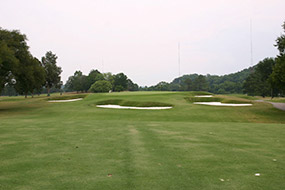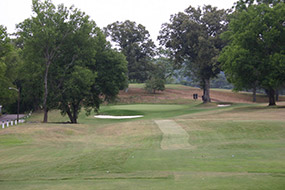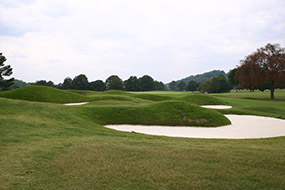One of the best-preserved Donald Ross layouts in America, the Holston Hills Country Club was formed in 1927, and built on a rolling property east of Knoxville, Tennessee. Renowned for its deep grass-faced bunkers and steep greens, the course is mostly set beneath the site’s major ridge and beautifully routed by Ross across the bumpy lower ground. Although technology has reduced the effectiveness of some driving challenges, the distinctive traps remain fraught with danger while the putting contours, which tend to follow the shape of the land, have become even more treacherous as green speeds have increased.
Each of the nines start by falling off the main ridge, with the 9th and 18th greens then benched back into the hillside. The par threes, in particular, are outstanding, and varied as they feature a diverse collection of target areas and test a range of shots. These include a short iron into a pimple green surrounded by sand, a cross-dam mid-iron into a hillock, a rising long iron and finally the falling 14th, its putting surface set attractively at the base of a hill. Other notable areas include the cape-style 2nd, the valley approach into the 3rd green, the skyline pitch shot into the 6th and the split high road/low road par five 7th. The 5th is another excellent three-shotter, played across relatively flat ground but with a series of superbly positioned bunkers to negotiate. Perhaps even more interesting is the 15th, which is cut by mounds from the tee but features a stunning second shot into an elevated green complex protected by humps, traps and a substantial back-to-front tilt.
Although the closing stretch may seem a little soft, it completes a wonderful examination of your game and manages to offer incentives to shoot for birdies with the appropriate risks of ending in deep trouble. As with many well-kept classics of this vintage, scratch golfers may find Holston Hills simple from the tee but it remains a terrific second shot course with players needing to balance the desire for uphill putts with the need to continually hit beyond the cruel false fronts.

 this course also has exceptional:
this course also has exceptional:


